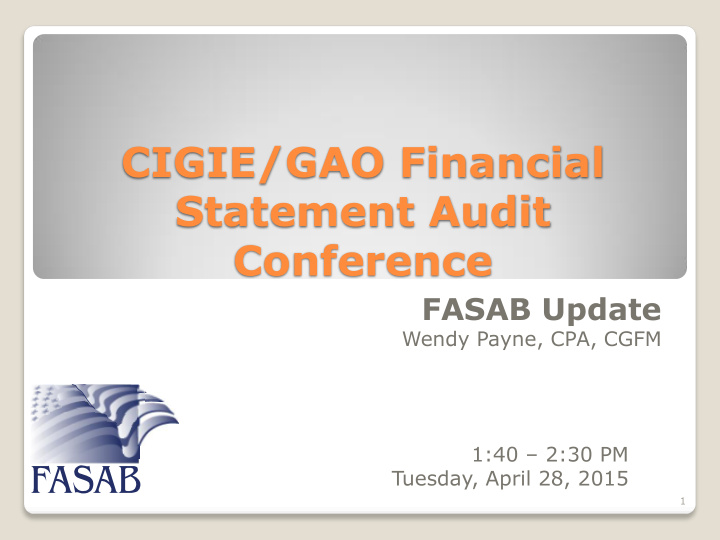



CIGIE/GAO Financial Statement Audit Conference FASAB Update Wendy Payne, CPA, CGFM 1:40 – 2:30 PM Tuesday, April 28, 2015 1
Disclaimer Views expressed are those of the speaker. The Board expresses its views in official publications. 2
OVERVIEW 25 Years Federal Reporting Entity Review of Current Projects: ◦ Reporting Model ◦ Risk Assumed ◦ Leases ◦ Public-Private Partnerships ◦ Department of Defense 3
Twenty-five Years 4
“…legislators generally considered management reform about as exciting as sorting cranberries…” ◦ Michael D. Serlin, Born-again financial management. Government Executive (May 1996). Sustained Management Reform 5
Memorable Moments at the Standards Setting Board Being key to realizing Getting “GAAP” the NPR goals Being the first and Not being terminated only country by the NPR presenting audited projections for SI and Getting pension and soon whole of OPEB liabilities right government flows Hearing budget Always having willing experts recommend volunteers! use of more accrual information Seeing the talent! 6
Reporting Entity – Are you ready? 7
Federal Reporting Entity – SFFAS 47 (effective FY2018) – Include in General Purpose Federal Financial Reports (GPFFR) all organizations: budgeted for, controlled with potential for risk or reward, or owned Does not specifically address particular entities. ◦ Provides for judgment about: Inclusion Classification Disclosure 8
Federal Reporting Entity (CONT.) Distinguish between consolidation entities and disclosure organizations Consolidation entities are: supported by general taxes and on-going decision making is more clearly linked to elected officials. Information for consolidation entities is to be consolidated in financial statements. 9
Federal Reporting Entity (CONT.) Disclosure organizations are: somewhat independent from elected officials, and may be financially self-sustaining. Information regarding such organizations is to be disclosed in notes with an emphasis on risk. 10
Federal Reporting Entity (CONT.) Also addresses: ◦ What entities are subject to SFFAS 34 – the GAAP hierarchy for federal entities ◦ What organizations to include in component reporting entity GPFFR ◦ How to deal with: FASB-basis information for consolidation entities Different year ends for disclosure organizations ◦ Related parties ◦ Amendments to SFFAC 2, Entity and Display 11
Current Projects 12
Reporting Model – Research Results Improvement Needed in the Statement of Net Cost: ◦ Now - cost by strategic goal ◦ Some prefer to focus on “cost” by organizations, programs, or projects ◦ Matching cost and output (and eventually outcome) is not so easy! ◦ Same terms used differently by different disciplines (cost per the budget versus cost per accrual principles versus cost per program evaluators) 13
Reporting Model – Research Results Improvement Needed in Budgetary Information : ◦ Not understandable or useful to non-specialists ◦ Hard to relate to cost (and non-financial performance) ◦ But important to: get right track resources So you can hold officials accountable. 14
Reporting Model – Forming Concepts Draft concepts will or may: integrate some existing information (SFFAC 1 and SFFAS 4 Concepts) discuss interoperability among GAAP based and transparency information Identify key differences between the government as a whole and components discuss ways to relate and disaggregate information 15
RISK ASSUMED Current Standards are limited to insurance contracts and explicit guarantees (other than loan guarantees). Implementation is: ◦ varied across government. ◦ not sufficiently understandable. Ideally, the project will lead to relevant risk assumed information across government. 16
RISK ASSUMED (cont.) - Three Phases - Phase I: Insurance and [Non-Loan] Guarantees Phase II: Entitlement Programs, including: National Defense, Security and Disaster response Other potential effects on future outflows: ◦ regulatory actions, ◦ Government Sponsored Enterprises (GSEs), etc. Phase III: Commitments Obligations Other risk areas 17
RISK ASSUMED (cont.) - Insurance & Guarantee Phase - Define federal Insurance and [Non-Loan] Guarantee programs Improve terminology Address measurement uncertainty regarding estimated losses on open contracts ◦ Potentially use expected value ◦ Improve disclosures Disclose risk assumed ◦ Narrative including risk factors ◦ Coverage in force (maximum loss) 18
Leases Are all leases financings? 19
Leases (cont.) FASAB is partnering with GASB to develop standards for governmental organizations. Tentative decision to establish a single model (with exceptions for short-term arrangements). ◦ Leases create assets consisting of the “right to use” a resource. ◦ Leases create liabilities consisting of the obligation to pay for the resource. The focus may be on the interest cost associated with leases. Intragovernmental exceptions 20
Public-Private Partnerships Due to budget pressures, federal agencies have increasingly turned to public-private partnerships (e.g., PPPs, P3s) to accomplish goals Transparency of the full costs and risks of such partnerships is the overall objective Specific objectives include: ◦ Defining terms (e.g., service concession arrangements, P3s) ◦ Providing guidance for the recognition and measurement of: ◦ assets and liabilities ◦ revenues and expenses ◦ risks ◦ Consider implications for other arrangements related to P3s (sale- leaseback or other long-term arrangements). 21
DoD Implementation Guidance SFFAS 3 – Are estimates for inventory and related property permitted? ◦ Proposal emerging – Permit many valuation approaches in establishing an opening balance SFFAS 6 – Treatment of Capital Improvements (separate estimates required or not) Internal Use Software ◦ The AAPC is developing an implementation guide. 22
Questions? 23
Contact and Website Information General inquiries can be directed to fasab@fasab.gov Phone: 202 512-7350 www.FASAB.gov ◦ Listserv (sign up for emails) ◦ Exposure Drafts ◦ Active Projects – assigned staff My contact info: ◦ paynew@fasab.gov ◦ (202) 512-7357 24
Recommend
More recommend